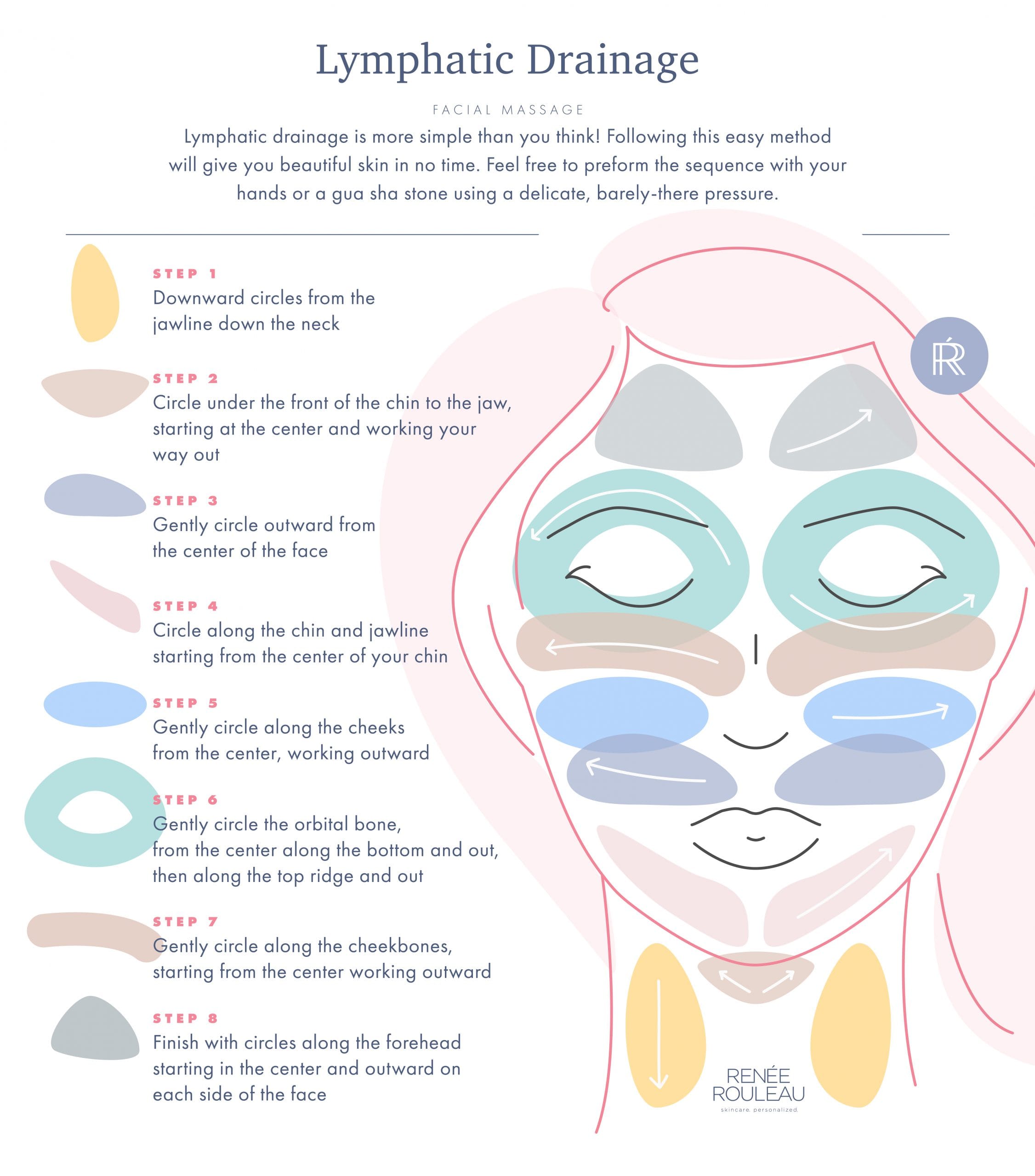Feeling sluggish or puffy? Your lymphatic system, the body’s natural detox system, might need some attention. This comprehensive guide explores lymphatic drainage, explaining its benefits, various techniques, and how you can support this vital system for optimal health.
Understanding Lymphatic Drainage and Its Benefits
Ever wonder how your body eliminates waste and toxins? Your lymphatic system, a network of vessels and nodes, plays a crucial role. It carries lymph, a fluid containing waste products, toxins, and immune cells, away from tissues. Lymphatic drainage, whether through massage or other methods, helps keep this fluid moving efficiently. Unlike blood circulation, which is powered by the heart, the lymphatic system relies on muscle contractions and movement. That’s where lymphatic drainage techniques come in—they assist this natural process.
Boosting lymphatic flow may offer several potential benefits:
- Reducing Swelling: Lymphatic drainage can be particularly helpful in managing lymphedema, a condition characterized by fluid buildup in tissues. It can also alleviate swelling after injuries or surgery.
- Enhancing Immunity: By efficiently removing waste and toxins, lymphatic drainage may support a healthy immune system, making it more resilient to infections.
- Supporting Detoxification: Lymphatic drainage aids the body’s natural detoxification processes, potentially leaving you feeling more energized and refreshed.
- Easing Fatigue and Congestion: Some studies suggest that improved lymphatic flow might reduce fatigue and sinus congestion, although more research is needed in these areas.
Exploring Different Lymphatic Drainage Techniques
Several approaches can encourage lymphatic flow:
- Manual Lymphatic Drainage (MLD): This specialized massage technique, performed by a certified therapist, uses gentle, rhythmic hand movements to stimulate lymph flow.
- Self-Lymphatic Drainage: You can learn simple self-massage techniques to support your lymphatic system daily. We’ll cover some of these later in the guide.
- Movement and Exercise: Regular physical activity, especially exercises involving deep breathing and muscle contractions, naturally boosts lymphatic circulation.
- Hydration: Drinking plenty of water is crucial for keeping lymph fluid thin and flowing smoothly.
Conditions That May Benefit from Lymphatic Drainage
Lymphatic drainage has shown promise in alleviating symptoms associated with various conditions, including:
- Lymphedema (primary and secondary): MLD is often a key part of lymphedema treatment.
- Post-surgical swelling: Lymphatic drainage can minimize swelling and bruising after surgery.
- Chronic fatigue: Early research suggests a link between improved lymphatic function and fatigue reduction, but more studies are needed.
- Skin conditions (acne, eczema, cellulite): Some individuals report that lymphatic drainage improves skin appearance by reducing inflammation and promoting detoxification. However, more research is required to confirm these benefits.
Precautions and Risks of Lymphatic Drainage
While generally safe, lymphatic drainage may not be suitable for everyone. Consult your doctor before trying it if you have:
- Active infections: Stimulating the lymphatic system during an infection could potentially spread it.
- Congestive heart failure: Lymphatic drainage might strain the heart.
- Deep vein thrombosis (DVT): There’s a slight possibility that lymphatic drainage could dislodge a blood clot.
Practicing Self-Lymphatic Drainage at Home
Incorporate these simple self-massage techniques into your routine:
- Deep Breathing: Diaphragmatic breathing creates a gentle pumping action that encourages lymph flow.
- Lymph Node Warm-up: Gently massage areas where lymph nodes are concentrated (neck, armpits, groin).
- Gentle Strokes: Using light pressure, stroke your skin towards your heart, guiding lymph fluid along its natural pathways.
Lifestyle Habits for a Healthy Lymphatic System
Beyond massage, several lifestyle choices influence lymphatic health:
- Balanced Diet: Fruits, vegetables, and whole grains provide nutrients for optimal lymphatic function.
- Regular Exercise: Even gentle walks stimulate lymphatic flow.
- Hydration: Adequate water intake keeps lymph fluid thin and mobile.
- Stress Management: Chronic stress can negatively impact the lymphatic system. Practices like yoga and meditation can be beneficial.
The Evolving Science of Lymphatic Drainage
Research on the lymphatic system is ongoing, and our understanding of its functions and the full potential of lymphatic drainage continues to evolve. Stay informed, listen to your body, and consult healthcare professionals for personalized advice.
What Does Lymphatic Drainage Do?
Lymphatic drainage plays a vital role in maintaining overall health. It acts as the body’s cleaning crew, removing waste products, toxins, and excess fluid. This process is crucial for various bodily functions, including:
- Waste Removal: Similar to a city’s sanitation system, the lymphatic system collects metabolic waste and toxins for disposal.
- Swelling Reduction: Lymphatic drainage helps reduce swelling (lymphedema) caused by fluid buildup in tissues due to injury, surgery, or medical conditions.
- Detoxification: While the liver and kidneys are primary detox organs, the lymphatic system contributes by filtering and removing harmful substances.
- Immune Support: Lymphatic drainage circulates immune cells, strengthening the body’s defense against infections.
Both professional lymphatic drainage therapies and self-massage techniques can promote lymphatic flow. Lifestyle factors like exercise, diet, and hydration also support lymphatic health. Research is ongoing, exploring the lymphatic system’s role in various health conditions, from skin issues to chronic fatigue. While promising, further studies are needed to confirm these potential benefits. Consulting a healthcare professional is crucial before starting any new therapy, especially with underlying health concerns.
| Potential Benefit | How it Might Work | Current Research Status |
|---|---|---|
| Reduced Swelling | Removes excess fluid from tissues | Well-established, especially for lymphedema. |
| Improved Immunity | Supports circulation of immune cells and removal of waste products that could hinder immune function. | Strong evidence, but more research is ongoing. |
| Enhanced Detoxification | Assists the body’s natural detoxification processes by removing waste and toxins. | Evidence suggests a role, but further studies are needed to fully understand the impact. |
| Improved Skin Health | May reduce puffiness and improve circulation, potentially contributing to healthier skin. | Some evidence, but more robust research is required. |
| Stress Reduction | Gentle massage and improved lymphatic flow might have a relaxing effect on the body. | Early research suggests potential benefits, but more studies are needed. |
Some individuals might experience mild, temporary side effects after lymphatic drainage therapy, like fatigue or aches. While generally safe, it might not be suitable for everyone, especially those with active infections or heart problems. Consulting a healthcare professional is crucial to determine if it’s the right approach.
Do I Need Lymphatic Drainage? Recognizing the Signs
A healthy lymphatic system is essential for well-being. When it’s not functioning optimally, several signs might suggest you could benefit from lymphatic drainage:
- Persistent Fatigue: Feeling constantly tired, even after adequate sleep.
- Unexplained Swelling: Puffiness in ankles, face, or abdomen, often worsening in the evening.
- Frequent Infections: Catching colds easily or experiencing slow-healing wounds.
- Aches and Pains: Muscle or joint soreness and stiffness.
- Digestive Issues: Bloating, constipation, or discomfort after eating.
- Skin Problems: Eczema, acne, or dry skin.
| Potential Sign | What it Might Feel Like |
|---|---|
| Persistent Fatigue | Constant tiredness, low energy, difficulty concentrating |
| Unexplained Swelling | Puffiness in ankles, face, or abdomen, often worse in the evening |
| Frequent Infections | Catching colds easily, slow-healing wounds |
| Aches and Pains | Muscle or joint soreness, stiffness |
| Digestive Issues | Bloating, constipation, discomfort after eating |
| Skin Problems | Eczema, acne, dry skin |
Manual lymphatic drainage can be helpful in improving lymphatic flow. Self-massage techniques can also be incorporated into your routine. However, consulting a healthcare professional is crucial to determine if lymphatic drainage is right for you and rule out other underlying conditions. Ongoing research continues to expand our understanding of lymphatic health.
Is Your Lymphatic System Clogged? Symptoms, Causes, and Solutions
A healthy lymphatic system is essential for well-being. Several indicators suggest your lymphatic system might need support:
- Swelling: Puffiness, especially in extremities, potentially accompanied by heaviness or tightness.
- Skin Changes: Hardening, thickening, dryness, itchiness, or increased skin infections.
- Digestive Problems: Constipation, bloating, or other irregularities.
- Recurring Infections: Frequent colds, sinus infections, or increased susceptibility to illness.
- Fatigue: Persistent tiredness and low energy.
- Brain Fog: Difficulty concentrating, memory issues, or mental fatigue.
- Enlarged Lymph Nodes: Swollen lymph nodes, particularly if persistent.
- Other Potential Signs: Allergies, inflammation, tighter rings, parasites (less common), mood changes.
Several factors can contribute to lymphatic congestion:
- Primary Lymphedema: A rare, inherited condition.
- Secondary Lymphedema: More common, resulting from damage/blockage due to cancer, infection, or surgery.
- Other Factors: Age, obesity, autoimmune conditions like rheumatoid arthritis.
| Sign/Symptom | Description |
|---|---|
| Swelling | Noticeable puffiness, often in extremities, accompanied by heaviness or tightness. |
| Skin Changes | Hardening, thickening, dryness, itchiness, and increased risk of skin infections. |
| Digestive Problems | Constipation, bloating, and other irregularities in bowel movements. |
| Recurring Infections | Frequent colds, sinus infections, and a general susceptibility to illness. |
| Fatigue | Persistent tiredness and low energy levels. |
| Brain Fog | Difficulty concentrating, memory problems, and mental fatigue. |
| Enlarged Lymph Nodes | Swelling of lymph nodes, especially if persistent. |
| Other | Increased allergies, inflammation, changes in ring fit, parasites (less common), mood changes. |
Several strategies can improve lymphatic flow:
- Exercise: Promotes circulation.
- Dry Brushing: Stimulates lymphatic flow.
- Dietary Changes: Reduce processed and inflammatory foods.
- Deep Breathing: Encourages lymphatic drainage.
- Hydration: Essential for fluid balance.
If you’re concerned about any of these symptoms, consult a healthcare professional for proper diagnosis and guidance. If you’re planning to travel to Muskege, Oklahoma, you’ll need to know its zip code. And if you want to learn more about the Lilly Pilly Syzygium, click here.
- Discover Long Black Pepper: Flavor & Health Benefits - April 25, 2025
- Shocking Twists: The Grownup Review: Unreliable Narration - April 25, 2025
- A Quiet Place Book vs Movie: A Deep Dive - April 25, 2025
















